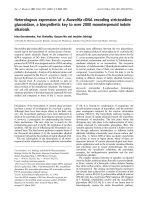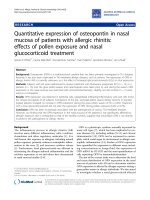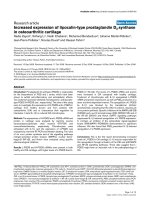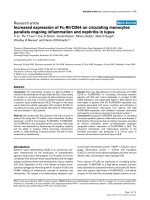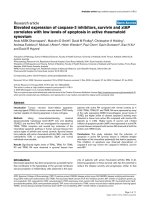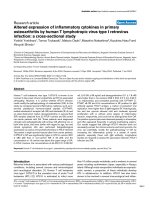Báo cáo Y học: Balanced expression of single subunits in a multisubunit protein, achieved by cell fusion of individual transfectants docx
Bạn đang xem bản rút gọn của tài liệu. Xem và tải ngay bản đầy đủ của tài liệu tại đây (170.38 KB, 6 trang )
Balanced expression of single subunits in a multisubunit protein,
achieved by cell fusion of individual transfectants
Lars Norderhaug
1
, Finn-Eirik Johansen
2
and Inger Sandlie
3
1
Antibody Design AS, Nesoddtangen, Norway;
2
Department of Pathology, Rikshospitalet, Norway;
3
Department of Biology,
University of Oslo, Norway
To establish stable cell lines that produce recombinant
multisubunit proteins, it is usually necessary to cotransfect
cells with several independent gene constructs. Here, we
show that a stepwise fusion of individually transfected cells,
results in a fused cell-line that secretes a complete multi-
subunit protein. Functional expression of recombinant
multisubunit proteins may require a defined expression ratio
between each protein subunit. The cell-fusion technology
described allows a predefined expression level of each sub-
unit. Using SIgA as a model protein we demonstrate that the
majority of the fused cells inherit the molar expression ratio
of the parental transfected cells. These results indicate that
simplified screening of clones expressing the expected sub-
unit ratios may be possible using the cell-fusion technology.
This technology may therefore be an alternative to generic
transfection methods for the establishment of cells that
produce multiprotein complexes such as antibodies, recep-
tors, ion channels and other multisubunit proteins.
Keywords: antibody; expression; fusion; SIgA; transfection.
To establish stable cell lines that produce recombinant
multisubunit proteins, it is generally necessary to introduce
vectors that direct the expression of each subunit gene. For
multisubunit proteins such as secretory antibodies [1,2],
receptors [3,4] and ion channels [5–8], a defined expression of
each unit may be essential for the specific function of the
mature protein product. This is usually achieved by cotrans-
fecting cells with several independent constructs or by
introducing a single vector harbouring several discrete
expression cassettes. Controlled expressions of several poly-
peptides within one cell have also been addressed using
different vector designs such as; multicistronic vectors where
each gene are controlled by internal ribosome entry site
(IRES) [9–11], panel of vectors [12] and multiple episomal
vectors [13]. We chose secretory IgA (SIgA) as a model
protein to investigate the potential of cell-fusion technology
for the expression of multisubunit proteins. SIgA is the major
immunoglobulin of external secretions and is composed of
four different polypeptide chains produced by two distinct
cells. Polymeric IgA (pIgA) is produced by B-cells after
assembly of light-, a- and joining (J)-chain [14]. SIgA is
subsequently generated when a secretory component (SC)
is covalently added to pIgA during transport across the
epithelial cells lining mucosal surfaces [15]. Expression of the
multisubunit SIgA has previously been described using other
transfection methods [2,16–18]. Although the principle of
cell-fusion is well established by hybridoma technology [19],
the development and application of this technology for
production of recombinant multisubunit proteins has not
been described previously. Here, we achieve multigene
expression by utilizing cell-fusion of individually transfected
cells, each expressing one or more genes that encode the
multisubunit protein. We show that the majority of clones
resulting from the fusion inherit the expression levels of the
parental cells, thus simplifying screening for clones with
stochiometric expression levels of each component that
secrete fully functional SIgA. Furthermore, we show that this
system enables high-level expression in mammalian cells,
which is often a goal in recombinant protein expression.
MATERIAL AND METHODS
Vectors and cloning of genes
Construction of the vector family pLNO and its use for
transfection and expression of immunoglobulin genes has
been described previously [20–22]. The human Ig a1
gene was subcloned into pLNO/Neo giving the vector
pLNOA1/Neo. The Ig heavy-chain variable-gene (VH)
SS-269VH [23], specific for the outer membrane protein of
the bacteria Neisseria meningitides, was subcloned into
pLNOA1/Neo giving pLNOA1/Neo-SS269. The human
Ig k gene was subcloned into pLNO/Neo, giving pLNOL/
Neo. The Ig light-chain variable-gene (VL) SS-269VL [23],
specific for the outer membrane protein of the bacteria
N. meningitides, was subcloned into pLNOL/Neo giving
pLNOL/Neo-SS269. The construction of the human
J-chain vector pCH (CMV-driven expression, hygromy-
cin B resistance) [2] and the human SC vector pcDNA(zeo)-
His
6
(CMV-driven expression, Zeocin resistance) has been
previously described [2].
Cell culture and transfection
CHO-K1 cells were obtained from ATCC (USA) and
cultured in HAM F-12 (F-12 derived from hamster) with
1m
ML
-glutamine supplemented with 10% fetal bovine
Correspondence to L. Norderhaug, Antibody Design AS, P.O.Box190,
N-1450 Nesoddtangen, Norway.
Fax: + 47 66960691, Tel.: + 47 66960690,
E-mail:
Abbreviations: IRES, internal ribosome entry site; SIgA, secretory IgA;
pIgA, polymeric IgA; J-chain, joining chain; SC, secretory component;
FITC, fluorescein isothiocyanate; HRP, horseradish peroxidase.
(Received 14 December 2001, revised 17 April 2002,
accepted 14 May 2002)
Eur. J. Biochem. 269, 3205–3210 (2002) Ó FEBS 2002 doi:10.1046/j.1432-1033.2002.03000.x
serum. All transfections were performed by electroporation
with a BTX ECM-600 electroporator (San Diego, CA,
USA) with the settings 200 V (500 VÆcm
)1
), 800 lFand
185 Ohm. All transfections were performed in 0.4 mm
cuvettes with 20 lg of plasmid DNA and 1 · 10
7
cells per
mL in 0.8 mL NaCl/P
i
at 0 °C giving a 12-ms pulse.
Following transfection, the cells were subsequently trans-
ferred into 25 mL Dulbecco’s modified Eagle’s medium
(DMEM) or HAM F-12 with 10% fetal bovine serum in
25 cm
2
flasks,andallowedtorecoverfor24hbefore
addition of appropriate antibiotics; 800 lgÆmL
)1
G418
(Invitrogen BV, the Netherlands) or 400 lgÆmL
)1
hygromy-
cin (Invitrogen BV, the Netherlands) or 400 lgÆmL
)1
Zeocin
(Invitrogen BV, the Netherlands). Three individual transfec-
tions were employed: (a) the vector pCH/J-chain/Hygro (J-
chain vector) (b) the vector pcDNA (zeo)his6/SC (SC vector)
and (c) cotransfection of the vectors pLNOL/Neo-SS269 (k
vector) and pLNOA1/Neo-SS269 (a1vector)inCHO-K1
cells. Cells were allowed to grow for 10 days before protein
expression was analysed.
Cell fusion
Cell fusion was performed in two individual steps (Fig. 1) by
mixing equal number of cells (3 · 10
7
cells) of each fusion
partner. Cells were centrifuged (5–10 min, 200–400 g) and
washed once in serum free medium. The cell mixture was
further spun down, and the supernatant was removed
completely. The pellet was broken by gently tapping on the
bottom of the tube and placed in a 37 °C water-bath.
Prewarmed 0.5 mL of 50% poly(ethylene glycol) 1500
(Boehringer Mannheim, Germany) was mixed with the cells
over a period of 1 min, under continuous stirring with a
pipette tip. The cell/poly(ethylene glycol) solution was stirred
for another 1–2 min before further addition of 1 mL
prewarmed medium under continuous stirring for 1 min.
An additional 3 mL of prewarmed medium was added the
same way. The fusion mixture was then slowly mixed with
10 mL of prewarmed medium and incubated for 5 min. The
cells were centrifuged, the supernatant discarded and growth
medium added to achieve a cell concentration of 5 · 10
5
cellsÆmL
)1
. The cells were allowed to recover for 24 h, and
then diluted 1 : 100 in 100 mL growth medium supplemen-
ted with antibiotics to select for both parental clones. The
cells were cultured with fresh medium every 3–5 days until
colonies appeared 10–14 days after the fusion. Clones were
selected and analysed as described below.
Detection of IgA, pIgA, and SIgA expression
and bound SC
Transfected and fused CHO-K1 cells were analysed for
production of IgA, pIgA or SIgA and IgA bound SC by
ELISA on supernatant of outgrown cultures. Triplets of
100 lL supernatant of individually fused clones were
transferred in dilutions 1 : 1, 1 : 5, 1 : 25 to microtiter
plates coated with 4 lgÆmL
)1
of N. meningitides OMV
(a gift from T. E. Michaelsen, National Institute of Public
Health, Norway). Secondary antibodies used for detection
were rabbit anti-(human IgA) Ig (DAKO; 1 : 5000 dilution)
and rabbit anti-SC Ig (DAKO; 1 : 3000 dilution) and
tertiary antibody used for detection was horseradish
peroxidase (HRP)-conjugated goat anti-(rabbit IgG) Ig
(DAKO; 1 : 3000 dilution). The absorbance was read by
TitertekÒ Multiskan (ICN Flow, USA). The amount of
IgA present in each supernatant was calculated relative to a
standard preparation with known concentration.
Verification of J-chain expression
To examine production of J-chain, transfected cells were
screened by immunofluorescence staining. CHO-K1 cells
transfected with J-chain were cultured on micro slides. Cells
were fixed and permeabilized in methanol ()20 °Cfor
4 min). The cells were then washed twice with NaCl/P
i
and
incubated at room temperature for 20 min with 1 : 3000
diluted rabbit anti-(J-chain) Ig (P. Brandtzaeg, LIIPAT,
National Hospital, Norway). Cells were then washed three
times with NaCl/P
i
and incubated for 20 min with (1 : 200)
fluorescein isothiocyanate (FITC)-conjugated goat anti-
(rabbit IgG) Ig (DAKO). Cells were washed as above and
analysed by fluorescence microscopy.
Verification of SC production
Transfected and fused CHO-K1 cells were analysed for
production of total SC, by a dot blot approach. Triplets of
Fig. 1. A schematic diagram of the fusion of cells producing individual
protein units of a multisubunit protein. Three transfected CHO-K1 cell
lines producing either IgA, J-chain or SC, respectively, were fused in
two steps; fusion I and fusion II. Fusion I between cells producing IgA
and J-chain resulted in clones producing pIgA. Fusion II between cells
producing pIgA and SC resulted in clones producing SIgA.
3206 L. Norderhaug et al. (Eur. J. Biochem. 269) Ó FEBS 2002
supernatants from individual clones were applied in 1 : 1,
1 : 5, 1 : 25, 1 : 125 dilutions onto poly(vinylidene difluo-
ride) paper (Millipore; Sweden), preincubated for 3–5 s in
methanol, followed by 5 min incubation in dH
2
Oand
subsequently 10 min incubation in blotting buffer. The
membranes were then dried at 37 °C for 1 h, before
incubation in 25 mL NaCl/P
i
/0.1% Tween-20 (NaCl/P
i
/
Tween) with 10% skimmed milk and 1 : 1000 diluted rabbit
anti-SC Ig. The membranes were then washed three times in
NaCl/P
i
/Tween and incubated with HRP-conjugated goat
anti-(rabbit IgG) Ig (Bio-Rad; 1 : 3000 dilution) for another
1 h. Finally, the membranes were washed three times in
NaCl/P
i
/Tween before addition of substrate (Bio-Rad) for
5 min. The membranes were covered with plastic film and
exposed to Kodak X-OMAT film for 15–60 s. Dot blot
density was analysed by
TOTALLAB
gel software (Phonetix,
UK). The amount of SC present in each supernatant was
calculated relative to a standard preparation with known
concentration.
Western blot of IgA, pIgA and SIgA
Aliquots of 10 lL supernatant from selected clones were
analysed under nonreducing conditions on a 4–15% Tris/
HCl SDS/PAGE ReadyGel (Bio-Rad) run at 200 V for 1 h.
The gel was blotted onto PVDF paper (Millipore; Sweden)
in a Bio-Rad Miniblotter for 1 h at 100 V. Following the
transfer, the membranes were washed in NaCl/P
i
for
5–10 min with gentle agitation, and blocked for 45 min in
NaCl/P
i
/Tween with 10% skimmed milk. The membrane
was washed once in NaCl/P
i
before incubation with either
1 : 5000 dilution rabbit anti-(human IgA) or 1 : 3000
dilution rabbit anti-(human SC) Ig for 1 h. The membranes
were washed twice followed by incubation with 1 : 3000
dilution HRP-conjugated goat anti-(rabbit IgG) Ig
(Immun-Star
TM
Chemiluminescent Protein Detection
Systems, Bio-Rad) for 1 h. The blot was developed as
described above and exposed to X-ray film for 1–10 min.
RESULTS
To obtain SIgA-producing cells we first established cells that
stably expressed the individual protein subunits by conven-
tional transfection. Transfection of the SC gene, the J-chain
gene and cotransfection of the a1 heavy-chain and k light-
chain genes resulted in clones that produced SC, J-chain or
IgA, respectively. Selected clones were then subjected to two
fusions: the first between IgA and J-chain producing cells,
and the second between pIgA-producing cells from the first
fusion and SC-producing cells (Fig. 1).
Generation of clones expressing IgA, J-chain or SC
To establish cells expressing IgA, CHO-K1 cells were
cotransfected with a1andk genes using the two vectors
pLNOA1/Neo-SS269 and pLNOL/Neo-SS269. Superna-
tants from 20 clones were analysed by ELISA and seven of
these were positive for IgA production. One of these clones,
IgA-29, was chosen for further expansion and fusion with
J-chain producing cells. The J-chain gene was transfected
into CHO-K1 cells using the vector pCH/J-chain/Hygro.
Because J-chain is retained within the endoplasmic reticu-
lum and only secreted when joined to IgA or IgM, cells were
screened for J-chain-expression by immunofluorescence.
Cells from 6 clones were fixed and stained with an anti-
(human J-chain) Ig to verify the presence of intracellular
J-chain. A further attempt to directly quantify the amount
of intracellular J-chain was avoided, as retention is closely
linked to degradation [24,25]. One clone, J-1, with high
fluorescence intensity was selected for further expansion and
fusion to IgA-29. The SC gene was transfected into CHO-
K1 cells on the vector pcDNA(zeo)his6/SC. Twenty-four
clones were analysed by dot blot as described, and six of
these were positive for SC production. One clone, SC-4,
was expanded for further fusion. The clones IgA-29
(4.5 lgÆmL
)1
) and SC-4 (2.3 lgÆmL
)1
) were chosen for cell
fusions because the amount of expressed protein on a molar
basis is almost equal in these cells, as the M
r
of IgA and SC
are 160 and 80 kDa, respectively.
Fusion of single transfectants to achieve
SIgA-producing clones
The first fusion of IgA-producing cells (IgA-29) and J chain-
producing cells (J-1) resulted in numerous G418 and
hygromycin B resistant colonies. The overall fusion effi-
ciency was as high as 1 · 10
)3
. Five colonies were analysed
for production of IgA and J-chain by ELISA. All five
colonies were shown to produce both polypeptide chains.
One clone (pIgA-D) producing polymeric IgA was expan-
ded for fusion with SC-producing cells (SC-4). This fusion
was as effective as the first and resulted in numerous G418,
hygromycin B and Zeocin resistant colonies. Expanded
clones from the second fusion expressed all four genes:
k-chain and a1-chain, J-chain and SC.
Expression levels and SIgA quality
To investigate the expression ratio between the introduced
protein components of the fused cell, an IgA and SC
expression level analysis was done. Whereas SC is readily
secreted without assembly with the other components, this is
not the case for a1 heavy-chain and J-chain. Both are
retained and degraded intracellularly unless in complex with
their appropriate partners. Uncomplexed k light-chain
shows some retention, but is also secreted as light-chain
dimers [26]. The parental cell IgA-29, the pIgA clone pIgA-
D, and eight SIgA clones (SIgA-1–8) were analysed by
ELISA for expression levels of IgA and total SC (Fig. 2A)
and by dot blot for total SC (Fig. 2A). The IgA expression
levels varied from 0.5 to 5.2 lgÆmL
)1
and total SC
expression levels varied from 0.5 to 2.3 lgÆmL
)1
(Fig. 2A).
Importantly, more than 50% of the fused clones showed
expression levels almost equal to the parental cells which
was 4.5 lgÆmL
)1
for IgA and 2.3 lgÆmL
)1
for SC (Fig. 2A).
The molar expression ratio between IgA and total SC was
calculated for each fused clone, and compared with the
molar expression ratio of the parental cells SC-4/pIgA-D.
The molar ratio varied from 0.9 to 2.2, while 50% of the
clones maintained the molar ratio of 1 (Fig. 2B). This
shows that the selection and isolation of clones expressing a
stochiometric or predefined ratio of different protein
subunits is well within reach of a simple screening proce-
dure. SC bound to IgA also correlated with IgA expression
levels in all fused clones shown by ELISA (data not shown).
Because SC only interacts with J-chain-positive pIgA, the
Ó FEBS 2002 Multi-subunit protein production by cell fusion (Eur. J. Biochem. 269) 3207
complexing of IgA and J-chain is a prerequisite for SC
binding. Therefore, the correlation between the IgA and SC
levels in all the clones demonstrated that a sufficient amount
of J-chain was available for SIgA complex formation. One
SIgA-producing clone (SIgA-3) along with pIgA-D and
IgA-29 were analysed by SDS/PAGE gel and Western blot
(Fig. 3) to characterize the molecular size and composition
of the secreted products. This Western blot clearly demon-
strated that cells fused to produce all the four polypeptides
of SIgA, assembled and secreted SIgA of the expected
molecular size with reactivity against antibodies towards
both IgA and SC. The fused cells expressed both monomeric
and polymeric IgA as described for hybridoma cells
expressing monoclonal IgA [27], and was also seen when
the J-chain gene was transfected into an IgA-producing
CHO cell line [2]. The production level of the fused cells
grown in culture, without any selective pressure, was
measured by ELISA for two months. During this time
period, no change in expression levels was observed. The
fused cells were also frozen and thawed without any change
in growth or expression rate. In conclusion the fused cells
behaved as their transfected parental cells with respect to
morphology, growth rate and expression rate.
DISCUSSION
Stable transfection of mammalian cells requires that the
gene of interest is integrated into the chromosome by a
nonhomologous recombination event [28,29]. This is a rare
event and results in a very low frequency of integration and
variable expression levels due to the so-called Ôposition
effectÕ [30] and the copy number of integrated genes [31–33].
It has been observed that the variation in expression levels
among individual clones varies with > 30-fold in a single
gene transfection assay [11,34–36] (L. Norderhaug &
I. Sandlie, unpublished data). Thus, to establish a single
cell line expressing defined ratios of multiple protein units,
excessive screening is necessary, as each gene introduced
into the cell multiplies the complexity of the screening.
Others have addressed the problem of stochiometric
expression by construction of special vectors with IRES
elements that guide bicistronic or multicistronic expression
[9–11,37]. However, the use of IRES elements may require
complex plasmid construction or be limited to the use of
short cDNAs due to the size of the complete gene.
Stochiometric expressions by multiple episomal vectors
[13,38–40] have been addressed. The advantage of episomal
vectors is the property of the vector to replicate extra-
chromosomally, and thereby eliminate the positional effect
[30] of chromosomal integrating vectors. However, for
stable expression of multiple genes over time, the usefulness
of such episomal vector is limited, mainly because of the
slow loss of the vector over time when unselected [39]. A
defined expression ratio between each protein subunit may
be essential for the specific function of the mature protein
product. Study of ion channels [8] and receptors [3,41] have
shown that their structure and functions actually depend on
the level of expression of the different subunits. Thus, cell-
fusion technology will allow generation of cells with a
Fig. 3. Western blot of assembled IgA, pIgA
and SIgA. SDS/PAGE and Western blot of
untransfected CHO-K1 cells (lane 1), IgA-29
(lane 2), pIgA-D (lane 3 and 5) and SIgA-3
(lane 4 and 6) detected by antihuman IgA or
strippedandredetectedwithantihumanSC,as
indicated. The blot shows assembly of all
protein subunits in the fused cells.
Fig. 2. IgA and total SC production levels (A) and molar expression
ratios (B). (A) IgA and SC expression levels of outgrown supernatants
of the clones: SC-4, IgA-29, pIgA-D and SIgA-1–8 measured in triplets
by ELISA or dot blot. (B) Calculation of the molar expression ratio
between the subcomponents SC and IgA in each fusion clone SIgA1-8
and also between their parental cells SC-4 and IgA-29. Calculations
were based on measured expression levels of both SC and IgA (A) and
the M
r
of SC (80 kDa) and IgA (160 kDa).
3208 L. Norderhaug et al. (Eur. J. Biochem. 269) Ó FEBS 2002
predefined expression level of each protein subunit and
hence predefined molar ratios. The result presented here
show that the fusion event typically does not alter the
expression level of the recombinant protein (Fig. 2B).
Furthermore, in the study of structure–function relation-
ships of protein complexes, individual components may be
altered by site directed mutagenesis. A cell line expressing
the altered gene product at a given level may then be fused
to constitute an altered complex. Cell-fusion is possible
using CHO-K1, one of the cell-lines most widely used for
recombinant protein production, and the technology is also
applicable to NS0 cells (L. Norderhaug & I. Sandlie,
unpublished data).
ACKNOWLEDGEMENTS
This research was supported by Oslo Research Park AS and The
Research Council of Norway.
REFERENCES
1. Chintalacharuvu, K.R. & Morrison, S.L. (1997) Production of
secretory immunoglobulin A by a single mammalian cell. Proc.
Natl Acad. Sci. USA 94, 6364–6368.
2. Johansen, F., Norderhaug, I., Roe, M., Sandlie, I. & Brandtzaeg,
P. (1999) Recombinant expression of polymeric IgA: incorpora-
tion of J chain and secretory component of human origin. Eur. J.
Immunol. 29, 1701–1708.
3. Tretter, V., Hauer, B., Nusser, Z., Mihalek, R., Hoger, H.,
Homanics, G., Somogyi, P. & Sieghart, W. (2001) Targeted
disruption of the GABA (subA) receptor (delta) subunit gene leads
to an upregulation of (gamma) (sub2) subunit-containing
receptors in cerebellar granule cells. J. Biol. Chem. 276, 10532–
10538.
4. Sieghart, W., Fuchs, K., Tretter, V., Ebert, V., Jechlinger, M.,
Hoger, H. & Adamiker, D. (1999) Structure and subunit com-
position of GABA (A) receptors. Neurochem. Int. 34, 379–385.
5. Xu,J.,Yu,W.,Wright,J.,Raab,R.&Li,M.(1998)Distinct
functional stoichiometry of potassium channel beta subunits.
Proc. Natl Acad. Sci. USA 95, 1846–1851.
6. Tucker, S., Pessia, M. & Adelman, J. (1996) Muscarine-gated K+
channel: subunit stoichiometry and structural domains essential
for G protein stimulation. Am. J Physiol. 271, H379–H385.
7. Inagaki, N., Gonoi, T. & Seino, S. (1997) Subunit stoichiometry of
thepancreaticbeta-cellATP-sensitiveK+channel.FEBS Lett.
409, 232–236.
8. Manganas, L. & Trimmer, J. (2000) Subunit composition
determines Kv1 potassium channel surface expression. J. Biol.
Chem. 275, 29685–29693.
9. Zhu, J., Musco, M. & Grace, M. (1999) Three-color flow cyto-
metry analysis of tricistronic expression of eBFP, eGFP, and
eYFP using EMCV-IRES linkages. Cytometry 37, 51–59.
10. Gurtu, V., Yan, G. & Zhang, G. (1996) IRES bicistronic expres-
sion vectors for efficient creation of stable mammalian cell lines.
Biochem. Biophys. Res. Commun. 229, 295–298.
11. Liu, X., Constantinescu, S., Sun, Y., Bogan, J., Hirsch, D.,
Weinberg, R. & Lodish, H. (2000) Generation of mammalian cells
stably expressing multiple genes at predetermined levels. Anal.
Biochem. 280, 20–28.
12. Cockett, M., Ochalski, R., Benwell, K., Franco, R. & Wardwell-
Swanson, J. (1997) Simultaneous expression of multi-subunit
proteins in mammalian cells using a convenient set of mammalian
cell expression vectors. Biotechniques 23, 406–407.
13. Horlick, R., Schilling, A., Samama, P., Swanson, R., Fitzpatrick,
V., Robbins, A. & Damaj, B. (2000) Combinatorial gene expres-
sion using multiple episomal vectors. Gene 243, 187–194.
14. Johansen, F., Braathen, R. & Brandtzaeg, P. (2000) Role of J
chain in secretory immunoglobulin formation. Scand. J. Immunol.
52, 240–248.
15. Norderhaug, I., Johansen, F., Schjerven, H. & Brandtzaeg, P.
(1999) Regulation of the formation and external transport of
secretory immunoglobulins. Crit.Rev.Immunol.19, 481–508.
16. Chintalacharuvu, K.R. & Morrison, S.L. (1999) Production and
characterization of recombinant IgA. Immunotechnology 4, 165–
174.
17. Frigerio,L.,Vine,N.,Pedrazzini,E.,Hein,M.,Wang,F.,Ma,J.
& Vitale, A. (2000) Assembly, secretion, and vacuolar delivery of a
hybrid immunoglobulin in plants. Plant Physiol. 123, 1483–1494.
18. Ma, J., Hiatt, A., Hein, M., Vine, N., Wang, F., van Stabila,
P.D.C., Mostov, K. & Lehner, T. (1995) Generation and assembly
of secretory antibodies in plants. Science 268, 716–719.
19. Kohler, G. & Milstein, C. (1975) Continuous cultures of fused cells
secreting antibody of predefined specificity. Nature 256, 495–497.
20. Sorensen, V., Rasmussen, I., Norderhaug, L., Natvig, I.,
Michaelsen, T. & Sandlie, I. (1996) Effect of the IgM and IgA
secretory tailpieces on polymerization and secretion of IgM and
IgG. J. Immunol. 156, 2858–2865.
21. Norderhaug, L., Olafsen, T., Michaelsen, T.E. & Sandlie, I. (1997)
Versatile vectors for transient and stable expression of
recombinant antibody molecules in mammalian cells. J. Immunol.
Methods 204, 77–87.
22. Olafsen, T., Rasmussen, I.B., Norderhaug, L., Bruland, O.S. &
Sandlie, I. (1998) IgM secretory tailpiece drives multimerisation of
bivalent scFv fragments in eukaryotic cells. Immunotechnology 4,
141–153.
23. Wang, J., Jarvis, G.A., Achtman, M., Rosenqvist, E., Michaelsen,
T.E., Aase, A. & Griffiss, J.M. (2000) Functional activities and
immunoglobulin variable regions of human and. Infect. Immun.
68, 1871–1878.
24. Klausner, R. & Sitia, R. (1990) Protein degradation in the
endoplasmic reticulum. Cell 62, 611–614.
25. Mancini, R., Fagioli, C., Fra, A., Maggioni, C. & Sitia, R. (2000)
Degradation of unassembled soluble Ig subunits by cytosolic
proteasomes: evidence that retrotranslocation and degradation are
coupled events. FASEB J. 14, 769–778.
26. Reddy, P., Sparvoli, A., Fagioli, C., Fassina, G. & Sitia, R. (1996)
Formation of reversible disulfide bonds with the protein matrix of
the endoplasmic reticulum correlates with the retention of
unassembled Ig light chains. EMBO J. 15, 2077–2085.
27. Stoll, T., Chappaz, A., von Stockar, U. & Marison, I. (1997)
Effects of culture conditions on the production and quality
of monoclonal IgA. In Enzyme and Microbial Technology,pp.
203–211.
28. Roth, D.B., Porter, T.N. & Wilson, J.H. (1985) Mechanisms of
nonhomologous recombination in mammalian cells. Mol. Cell.
Biol. 5, 2599–2607.
29. Roth, D.B. & Wilson, J.H. (1986) Nonhomologous recombina-
tion in mammalian cells: role for short sequence homologies in the
joining reaction. Mol. Cell. Biol. 6, 4295–4304.
30. Wilson, C., Bellen, H. & Gehring, W. (1990) Position effects on
eukaryotic gene expression. Annu.Rev.CellBiol.6, 679–714.
31. Zastrow, G., Koehler, U., Muller, F., Klavinius, A., Wegner,
M., Wienberg, J., Weidle, U.H. & Grummt, F. (1989) Distinct
mouse DNA sequences enable establishment and persistence of
plasmid DNA polymers in mouse cells. Nucleic Acids Res. 17,
1867–1879.
32. Pulm, W. & Knippers, R. (1985) Transfection of mouse fibroblast
cells with a promoterless herpes simplex virus thymidine kinase
gene: number of integrated gene copies and structure of single and
amplified gene sequences. Mol. Cell. Biol. 5, 295–304.
33. Hemann, C., Gartner, E., Weidle, U.H. & Grummt, F. (1994)
High-copy expression vector based on amplification-promoting
sequences. DNA Cell Biol. 13, 437–445.
Ó FEBS 2002 Multi-subunit protein production by cell fusion (Eur. J. Biochem. 269) 3209
34. Bebbington, C.R., Renner, G., Thomson, S., King, D., Abrams,
D. & Yarranton, G.T. (1992) High-level expression of a
recombinant antibody from myeloma cells using a glutamine
synthetase gene as an amplifiable selectable marker Biotechnology
10, 169–175.
35. Hendricks, M.B., Banker, M.J. & McLaughlin, M. (1988) A high-
efficiency vector for expression of foreign genes in myeloma cells.
Gene 64, 43–51.
36. Wurm, F.M., Johnson, A., Ryll, T., Ko
¨
hne, C., Scherthan, H.,
Glaab, F., Lie, Y.S., Petropoulos, C.J. & Arathoon, W.R. (1996)
Gene transfer and amplification in CHO cells. Efficient methods
for maximizing specific productivity and assessment of genetic
consequences. Ann. NY Acad. Sci. 782, 70–78.
37. Martinez-Salas, E. (1999) Internal ribosome entry site biology and
its use in expression vectors. Curr. Opin. Biotechnol. 10, 458–464.
38. Van, C.K., Vanhoenacker, P., Duchau, H. & Haegeman, G. (2000)
Molecular integrity and usefulness of episomal expression vectors
derived from BK and Epstein–Barr virus. Gene 253, 293–301.
39. Vanhoenacker, P. & Haegeman, G. (2000) Episomal vectors for
gene expression in mammalian cells. Eur. J. Biochem. 267, 5665–
5678.
40. Mizuguchi, H., Hosono, T. & Hayakawa, T. (2000) Long-term
replication of Epstein–Barr virus-derived episomal vectors in the
rodent cells. FEBS Lett. 472, 173–178.
41. Eertmoed, A., Vallejo, Y. & Green, W. (1998) Transient expression
of heteromeric ion channels. Methods Enzymol. 293, 564–585.
3210 L. Norderhaug et al. (Eur. J. Biochem. 269) Ó FEBS 2002



